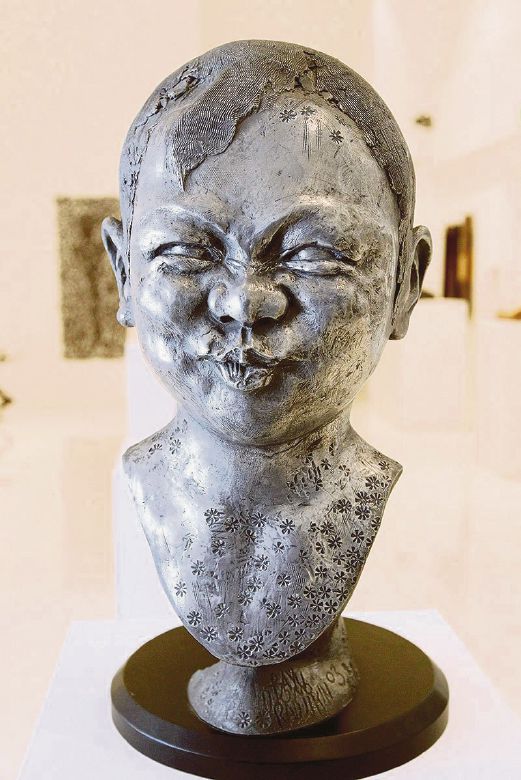For The Imaginary Space is an art showcase that besieges the senses in many different ways, writes Sarah NH Vogeler
WALKING into the exhibition, For The Imaginary Space, you immediately get the sense that although it is art on display, the show is more about the hearts of its owners. It’s a collection of sculptures and installations carefully and lovingly amassed over the span of two decades by lawyer Pakhruddin and his wife Fatimah Sulaiman.
The space itself could not possibly do real justice to the selections, but what space could? Short of a sprawling football field? In this instance, the curating was attractively finished. Each work has been meticulously picked after what must be clearly heart-wrenching decisions, (considering the true number of works in their private collection) and the audience is presented with a rare opportunity to reexamine past works, some which we have not seen in decades, and in some instances, mediums which the artist/s involved do not engage in, at least not for public consumption, for a long while now.
Case in point is Bayu Utomo Radjikin’s sassy 2004 aluminium and brass powder reinforced with resin “Growing”, Edition 5/5.
We can never get enough of the allure of sculptures and installations, and the alliance between these collectors and The Edge Galerie was one that was deeply awaited. I was given a tour of Pakha and Faty’s collections, comprising works of a vast array, extensive, more than a year ago, and the ones on show For The Imaginary Space is a fraction of what is in their growing treasure trove.
To speak of each work in the exhibition would take hours, and each work deserves elaboration. But a writer too has favourites. Umibaizurah Mahir’s 2006/2007 Toys (Gerabak) is one, with its fascinating miniature ceramic models on wheels arranged on horizontal wood shelves. The word “gerabak” is a suggestion of a continuous motion, and the charming moveable figurines, some narrow and pinched out into numerous twirls, others dispersed out slickly at the ends, are a moveable feast for the eyes and mind. These are “toys” you’d not want to share with others. As Shel Silverstein said in A Light In The Attic:
Now I lay me down to sleep,
I pray the Lord my soul to keep,
And if I die before I wake,
I pray the Lord my toys will break.
So none of the other kids can use ‘em....
Another which jumps to attention is Anurendra Jegadeva’s 2001 The Line, a Sanyo rice cooker painted with images of people in various poses, some bored, some mildly annoyed, mostly waiting for something. The artist said: “The rice cooker is really a migrant deity, and always situated in the hall, and eating developed into a crucial thing for migrants because that is a piece of home”.
I couldn’t take my eyes off it — partly because Anu’s works have always resonated deeply within, but also because it reminded me of my own years working for an airline where 90 per cent of us carried a miniature version of a rice cooker, except ours was rectangular-shaped and we dubbed it The Aladdin.
Sharmiza Abu Hassan’s 2004 Alegori 1: Hati Nyamuk, comprising seven entwined hearts in steel, magnifying glass, wire mesh, copper tubing and culminating with Alegori Ledang Study with Arabic letters 1 to 7 is the first thing seen upon entering the gallery.
The legend of Puteri Gunung Ledang, her outrageous demands of seven dishes of mosquito hearts among others in exchange for her hand in marriage, sparked a fiery debate on the full description of the structural and functional mechanics of the mosquito heart, and theories on extraction methods. Sharmiza’s piece is an example of how desires and lust can wreak complete ruin.
Sharon Chin’s 2002 Monster Series, of ghouls, headless ghosts, gargoyles, unicorns and manticores all sequestered in a darkened room and visible via mini torchlights provided, lends an ominous quality to works that’s already portentous.
The artist’s Weeds/Rumpai one night show where wild plants were painted on political party flags, was the most recent I caught in March 2013. Although her collaboration with a major multinational conglomerate company fell through recently, it could not in any way diminish that disturbingly-beautiful use of mythic sea monster Kraken tentacles in her artwork. The Monster Series, which demonstrates Chin’s genius at unravelling “opinions,” are interactive installations that probes suppression as a contradictory and intricate process, and makes one yearn for more from this enthralling artist.
At the time of writing, I was re-reading Virginia Woolf’s A Room Of One’s Own, for the 50th time, a read which never ceases to illuminate. For The Imaginary Space becomes a room of one’s own, and for as long as you are in it, there’s beauty and mystery, uneasiness and elation, a landscape for a myriad of emotions, of realities delightfully conjured in our heads.
As Woolf said:
“What is meant by ‘reality’? It’d seem to be something very erratic, very undependable - now to be found in a dusty road, now in a scrap of newspaper in the street, now a daffodil in the sun. It lights up a group in a room and stamps some casual saying. It overwhelms one walking home beneath the stars and makes the silent world more real than the world of speech. Sometimes, too, it seems to dwell in shapes too far away for us to discern what their nature is. But whatever it touches, it fixes and makes permanent..”
For The Imaginary Space is a body of collection based on many things — the most being this “principle of delight”, about being in the throbs of conception and process, about mysteries, about spirituality, about falling in love.
For The Imaginary Space
When: Until Dec 19
Where: The Edge Galerie Kuala Lumpur, G5 & G6 , Mont’ Kiara Meridin, 19 Jalan Duta Kiara, Mont’ Kiara, KL






